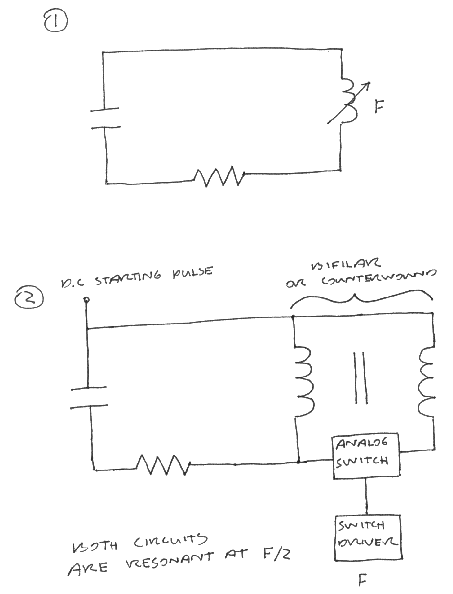
by Fred B. Epps
Created on 18 August 97
Date : 08/18/1997 12:22:23 From: fepps@halcyon.com (Fred Epps) Hi All! Although the study of scalar effects is inherently interesting and valuable, I don't believe it is necessary to invoke scalar waves to demonstrate overunity with a device similar to the TEP. Consider circuit 1 below. This is the basic parametric inductive circuit. It is known (maybe not WELL known) that if the inductance in this circuit is varied periodically at freq F, an oscillating current will develop at F/2.
It is generally believed that the energy needed to vary the inductance is exactly the same as the energy in the current. For some time on the list I have questioned whether there is any inherent connection between these two values. Now look at circuit 2. A bifilar or counterwound coil on a ferrite core has been substituted for the variable inductor in circuit 1. An analog switch driven by a square wave generator has been interposed between the two windings. The result is that for half a cycle any current passing through the circuit goes through one side of the bifilar inductor and for the other half the current goes through both sides. The result is that the total inductance goes from a high value to a very low value. This varying inductance operates in the same way as the variable inductance in circuit 1 and a current builds. The value of this current is based on depth of variation of the inductance, and the load resistance. Since the variation is high, the current will be high. On the other hand the energy needed to switch this current through the second half of the inductor is small. The obvious result is a much larger output than input. I am not a builder by nature, but this is a simple circuit that I could build. Unfortunately I don't have any way of testing it once I've built it (no scope etc.) I would appreciate it if one of you electronics wizards could put it together and test it out. There are a few more details that would need to be discussed so contact me. The original idea for this circuit is based on a concept of Jean-Louis Naudin's. I also want to thank Stuart Rae for his suggestions and help.